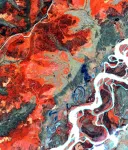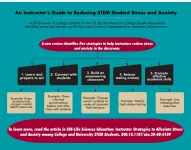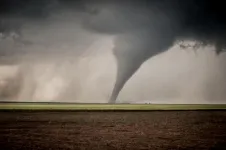(Press-News.org) Scientists regularly use remote sensing drones and satellites to record how climate change affects permafrost thaw rates -- methods that work well in barren tundra landscapes where there's nothing to obstruct the view.
But in boreal regions, which harbor a significant portion of the world's permafrost, obscuring vegetation can stymy even the most advanced remote sensing technology.
In a study published in January, researchers in Germany and at the University of Alaska Fairbanks' Geophysical Institute developed a method of using satellite imagery to measure the depth of thaw directly above permafrost in boreal ecosystems. Rather than trying to peer past vegetation, they propose a unique solution that uses variations in forest color to infer the depth of permafrost beneath.
The forest for the trees
Permafrost deposits in the northern hemisphere have been continuously frozen for hundreds of thousands of years. The soil layer directly above that of permafrost, however, is much more dynamic -- freezing and thawing with the seasons and growing or shrinking as it interacts with different types of vegetation at the surface.
Because permafrost in boreal regions is often overlaid with thick forest cover, typical methods of measuring permafrost and the active layer that work well in tundra regions -- like using pulsed lasers or radar that penetrate the soil -- are ineffective and can give spurious results.
"The canopies get in the way in forested regions," said Christine Waigl, a researcher in the Geophysical Institute at the University of Alaska Fairbanks and co-author on the study. "Some remote sensing instruments can penetrate the vegetation cover, but the interpretation requires specialized knowledge."
Instead of looking past the forest cover, scientists have turned to a variety of indirect methods. One approach is to assign categories to vegetation in order to obtain broad estimates for the size of the active layer underneath. The results can be imprecise -- similar to the difference between a sketch of a landscape and a high-resolution photo of it.
Instead, lead author Veronika Döpper, a researcher at the Berlin Institute of Technology, took a different approach, one in which she viewed the vegetative landscape as a continuum.
"In natural forests, the plants around you don't just fall into one category or the other with no gradient in between," said Döpper. "So in our study, rather than saying we had a birch-dominated forest or a black spruce-dominated forest with corresponding deep or shallow permafrost, we used our satellite imagery to see the gradient between the two."
Remote sensing color palette
To achieve this goal, Döpper obtained satellite imagery of the forests surrounding the city of Fairbanks, Alaska, that were taken during the summer of 2018. In order to know what she was looking at, Döpper set up over 65 10-by-10 meter plots outside Fairbanks that same summer in which she identified all the trees and shrubs, directly measured the depth of the active layer and recorded the location with GPS.
By using the GPS coordinates to locate each plot on the satellite maps, Döpper could then say how the total number of species in a given plot contributed to the color of those plots as seen in her remote sensing imagery.
"Different types of vegetation will have completely different tones in their color spectra and reflectances, which we can use to map vegetation composition," said Döpper.
With her plots as color guides, reflectances could then determine the exact type of vegetation growing over large swaths of forested and unforested areas outside of Fairbanks and, by proxy, could estimate the precise thaw depths for the same area.
Not only does this new approach promise to provide more accurate and abundant estimates of permafrost depth for use in climate modeling, it's also a valuable tool for communities in boreal regions.
When permafrost melts, the runoff bores channels through the soil, destabilizing the topography overhead. This can result in ground subsidence and landslides, endangering lives and posing risks to infrastructure.
Over 80% of Alaska is covered in permafrost. As these deposits continue to melt, innovative methods of monitoring their disappearance will be essential in more ways than one.
INFORMATION:
They can hear well up to about forty years old, but then suddenly deafness strikes people with DFNA9. The cells of the inner ear can no longer reverse the damage caused by a genetic defect in their DNA. Researchers at Radboud university medical center have now developed a "genetic patch" for this type of hereditary deafness, with which they can eliminate the problems in the hearing cells. Further research in animals and humans is needed to bring the genetic patch to the clinic as a therapy.
Hereditary deafness can manifest itself in different ways. Often the hereditary defect (mutation) immediately causes deafness from birth. Sometimes, as with DFNA9, you experience the initial ...
Philadelphia, March 2, 2021--Taking the first deep dive into how the immune system is behaving in patients with multisystem inflammatory syndrome in children (MIS-C), researchers at Children's Hospital of Philadelphia (CHOP) and the Perelman School of Medicine at the University of Pennsylvania have found that children with this condition have highly activated immune systems that, in many ways, are more similar to those of adults with severe COVID-19. The results, published today in Science Immunology, show that better understanding the immune activation in patients with MIS-C could not only help better treat those patients but also improve treatment for adults with ...
A new study of patients with Multisystem Inflammatory Syndrome in Children (MIS-C), a rare but severe complication of COVID-19 in children, reveals distinct immune features of COVID-19 not seen in adults that may clue scientists in to why SARS-CoV-2 infection manifests differently in children compared with adults. Their results showed that although the immune landscape in pediatric COVID-19 was similar to that in adults, MIS-C patients uniquely exhibited increased activation of a blood vessel-patrolling CD8+ killer T cell subset, and all pediatric COVID-19 patients harbored greater B cell frequencies for a more prolonged period of time than observed in healthy adults. MIS-C is characterized by pervasive inflammation, an array of symptoms ranging from fever ...
Orange, Calif. - Even before the COVID-19 pandemic, college students were reporting record levels of stress and anxiety. According to the American College Health Association END ...
The Deepwater Horizon disaster began on April 20, 2010 with an explosion on a BP-operated oil drilling rig in the Gulf of Mexico that killed 11 workers. Almost immediately, oil began spilling into the waters of the gulf, an environmental calamity that took months to bring under control, but not before it became the largest oil spill in the history of the petroleum industry.
Nearly 10 years have passed since then, and the oil slick has long since dispersed. Yet, despite early predictions, area wildlife are still feeling the effects of that oil, and research published in Environmental Toxicology and Chemistry has shown that negative health impacts have befallen not only dolphins alive at the time of the spill, but also in their young, born years later.
A team of researchers, including ...
When central nervous system cells in the brain and spine are damaged by disease or injury, they fail to regenerate, limiting the body's ability to recover. In contrast, peripheral nerve cells that serve most other areas of the body are more able to regenerate. Scientists for decades have searched for molecular clues as to why axons -- the threadlike projections which allow communication between central nervous system cells -- cannot repair themselves after stroke, spinal cord damage, or traumatic brain injuries.
In a massive screen of 400 mouse genes, Yale School of Medicine ...
Disruptions in the circadian rhythms in lung cells may explain why adults who survived premature birth are often more at risk of severe influenza infections, suggests a study in mice published today in eLife.
Dramatic improvements in the care of infants born prematurely have allowed many more to survive into adulthood. Yet ex-preemies can face several long-term side effects of the life-saving care they received. The study suggests potential new approaches to treating lasting lung problems in those born prematurely.
Many premature infants are not able to breathe on their own and require oxygen to survive. ...
College course syllabi written in a warm, friendly tone are more likely to encourage students to reach out when they are struggling or need help, a new study from Oregon State University found.
Conversely, when a syllabus is written in a more cold, detached tone, students are less likely to reach out.
The study also compared the effect of syllabus tone with the effect of a deliberate "Reach out for help" statement included in the document.
"The instructor has to ask themselves, what's the first point of contact with the class for the student? In an online class and in remote learning, the syllabus is often the ...
The United States experiences more tornadoes than any other country, with a season that peaks in spring or summer depending on the region. Tornadoes are often deadly, especially in places where buildings can't withstand high winds.
Accurate advanced warnings can save lives. A study from the University of Washington and the National Oceanic and Atmospheric Administration describes a new way to rate and possibly improve tornado warnings. It finds that nighttime twisters, summer tornadoes and smaller events remain the biggest challenges for the forecasting community.
"This new method lets us measure how forecast skill is improving, decreasing or staying the same in different situations," said Alex ...
A recent study of how human resources professionals review online information and social media profiles of job candidates highlights the ways in which so-called "cybervetting" can introduce bias and moral judgment into the hiring process.
"The study drives home that cybervetting is ultimately assessing each job candidate's moral character," says Steve McDonald, corresponding author of the study and a professor of sociology at North Carolina State University. "It is equally clear that many of the things hiring professionals are looking at make it more likely for ...


